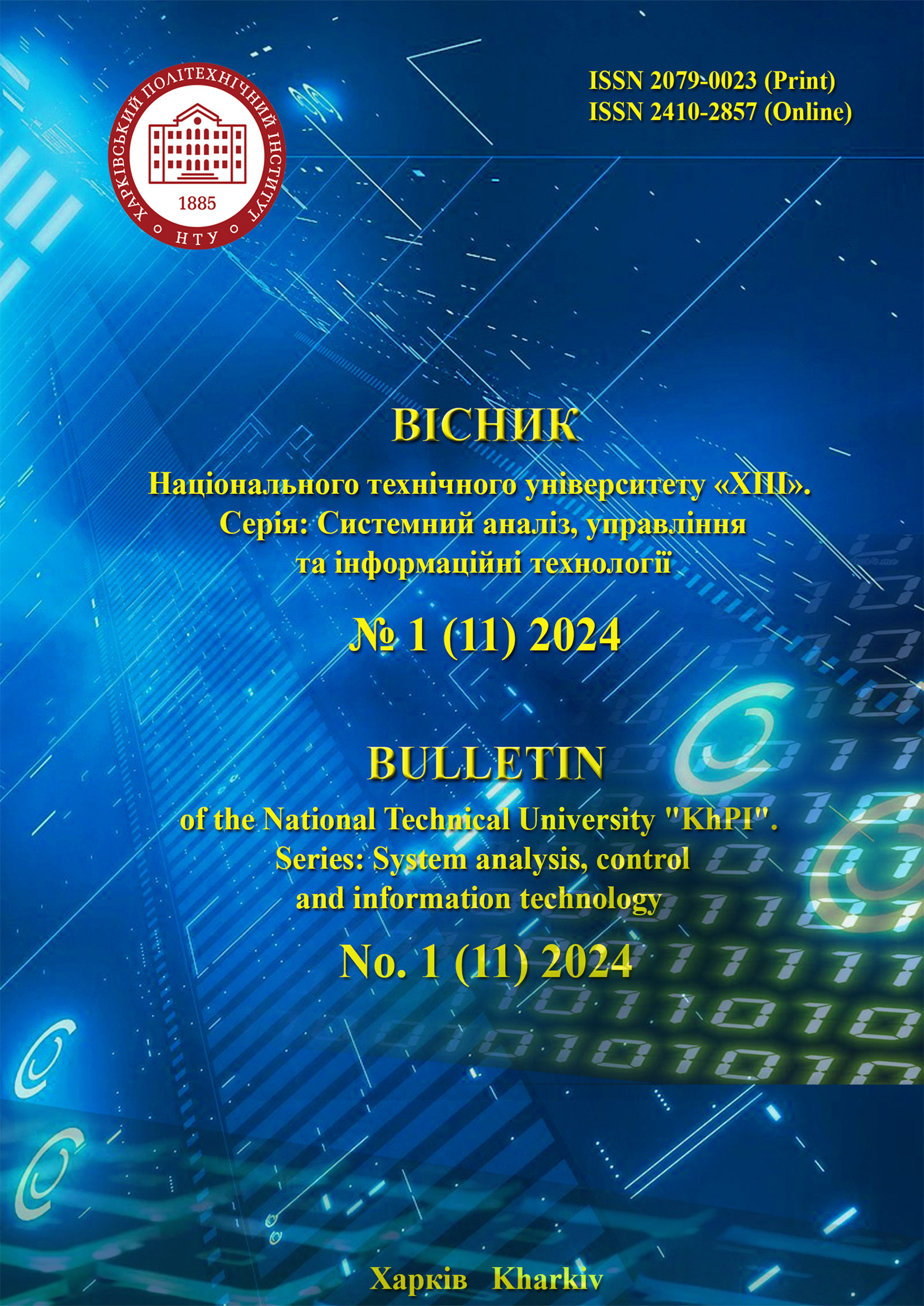DEVELOPMENT AND RESEARCH OF SOFTWARE SOLUTION FOR BUSINESS PROCESS MODEL CORRECTNESS ANALYSIS USING MACHINE LEARNING
DOI:
https://doi.org/10.20998/2079-0023.2024.01.06Keywords:
business process modeling, model quality, complexity measures, machine learning, logistic regression, software solutionAbstract
Poorly designed business process models are a source of errors and the subsequent costs associated with these errors, such as monetary costs, lost time, or even some harmful impact on people or the environment if the erroneous business process models are associated with critical industries. The BPM (Business Process Management) lifecycle usually consists of designing, implementing, monitoring, and controlling the business process execution, but it lacks continuous quality control of the created BPMN (Business Process Model and Notation) models. Thus, this paper considers the problem of business process models classification based on their correctness, which solution will ensure quality control of the designed business process models. Thus, this study aims to improve the quality of business process models by developing a software solution for business process models classification based on their correctness. The subject of the study is the process of business process models classification based on their correctness, which uses quality measures and thresholds, usually, complexity measures. The subject of the study is a software solution for business process models classification based on their correctness. Therefore, in this study, the algorithm to solve the problem of BPMN models classification using logistic regression, interface complexity, and modularity measures is proposed, the software requirements are determined, the software development tools are selected, the software for business process models classification based on their correctness is designed, the corresponding software components are developed, the use of a software solution for solving the problem of business process models classification based on their correctness is demonstrated, the obtained results are analyzed and discussed. The developed software indicates high performance of BPMN models classification based on their correctness, achieving high accuracy (99.14 %), precision (99.88 %), recall (99.23 %), and F-score (99.56 %), highlighting the high performance of modeling errors detection.
References
Business Process. Available at: https://www.ibm.com/docs/en/bpm/8.5.0?topic=processes-business (accessed: 15.03.2024).
Business Process. Available at: https://www.gartner.com/en/information-technology/glossary/business-process (accessed: 15.03.2024).
Business Process. Available at: https://www.techopedia.com/definition/26363/business-process (accessed: 20.03.2024).
Dumas M., La Rosa M., Mendling J., Reijers H. A. Fundamentals of Business Process Management. Available at: https://doi.org/10.1007/978-3-662-56509-4 (accessed: 20.03.2024).
Kopp A., Orlovskyi D. Towards Intelligent Technology for Error Detection and Quality Evaluation of Business Process Models. Available at: https://ceur-ws.org/Vol-3373/keynote1.pdf (accessed: 27.03.2024).
Business Process Model and Notation (BPMN), Version 2.0. Available at: https://www.omg.org/spec/BPMN/2.0/PDF (accessed: 28.03.2024).
von Rosing M., White S., Cummins F., de Man H. Business Process Model and Notation (BPMN). Available at: https://doi.org/10.1016/B978-0-12-799959-3.00021-5 (accessed: 28.03.2024).
van der Aals W. M. P. Business Process Modeling Notation. Available at: https://doi.org/10.1007/978-1-4614-8265-9_1195 (accessed: 04.04.2024).
Kopp A., Orlovskyi D. Towards the Software Solution for Complexity Minimization of Business Process Models to Improve Understandability. Available at: https://ceur-ws.org/Vol-3426/paper22.pdf (accessed: 04.04.2024).
Ayech H. B. H., Ghannouchi S. A., El Hadj Amor E. A. Extension of the BPM lifecycle to promote the maintainability of BPMN models. Available at: https://doi.org/10.1016/j.procs.2021.01.239 (accessed: 09.04.2024).
Tsakalidis G., Vergidis K. A Roadmap to Critical Redesign Choices That Increase the Robustness of Business Process Redesign Initiatives. Available at: https://doi.org/10.3390/joitmc7030178 (accessed: 09.04.2024).
Taherdoost H. Classification of Machine Learning Algorithms. Available at: https://doi.org/10.1007/978-981-16-8403-6_38 (accessed: 10.04.2024).
Sekeroglu B., Hasan S. S., Abdullah S. M. Comparison of Machine Learning Algorithms for Classification Problems. Available at: https://doi.org/10.1007/978-3-030-17798-0_39 (accessed: 10.04.2024).
Bisong E. Understanding Logistic Regression. Available at: https://doi.org/10.1007/978-1-4842-4470-8_20 (accessed: 12.04.2024).
Han W., Wang R., Huang D., Xu C. Large-Scale ALS Data Semantic Classification Integrating Location-Context-Semantics Cues by Higher-Order CRF. Available at: https://doi.org/10.3390/s20061700 (accessed: 15.04.2024).
Ahsan M. et al. Effect of Data Scaling Methods on Machine Learning Algorithms and Model Performance. Available at: https://doi.org/10.3390/technologies9030052 (accessed: 15.04.2024).
Functional and Nonfunctional Requirements. Available at: https://doi.org/10.1007/978-1-4302-0528-9_4 (accessed: 15.04.2024).
Node.js. Available at: https://nodejs.org/en/ (accessed: 18.04.2024).
TensorFlow. Available at: https://www.tensorflow.org/ (accessed: 18.04.2024).
bpmn.io. Available at: https://bpmn.io/ (accessed: 18.04.2024).
MongoDB. Available at: https://www.mongodb.com/ (accessed: 18.04.2024).
Reussner R. et al. Managed Software Evolution. Available at: https://doi.org/10.1007/978-3-030-13499-0 (accessed: 18.04.2024).
BPMN for research. Available at: https://github.com/camunda/bpmn-for-research (accessed: 20.04.2024).
Ming Ting K. Confusion Matrix. Available at: https://doi.org/10.1007/978-0-387-30164-8_157 (accessed: 21.04.2024).
Downloads
Published
How to Cite
Issue
Section
License

This work is licensed under a Creative Commons Attribution 4.0 International License.
Authors who publish with this journal agree to the following terms:
- Authors retain copyright and grant the journal right of first publication with the work simultaneously licensed under a Creative Commons Attribution License that allows others to share the work with an acknowledgement of the work's authorship and initial publication in this journal.
- Authors are able to enter into separate, additional contractual arrangements for the non-exclusive distribution of the journal's published version of the work (e.g., post it to an institutional repository or publish it in a book), with an acknowledgement of its initial publication in this journal.
- Authors are permitted and encouraged to post their work online (e.g., in institutional repositories or on their website) prior to and during the submission process, as it can lead to productive exchanges, as well as earlier and greater citation of published work (See The Effect of Open Access).


